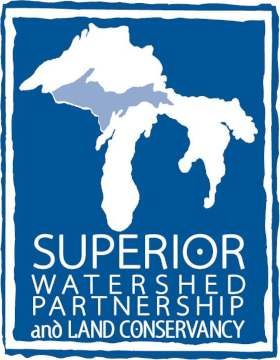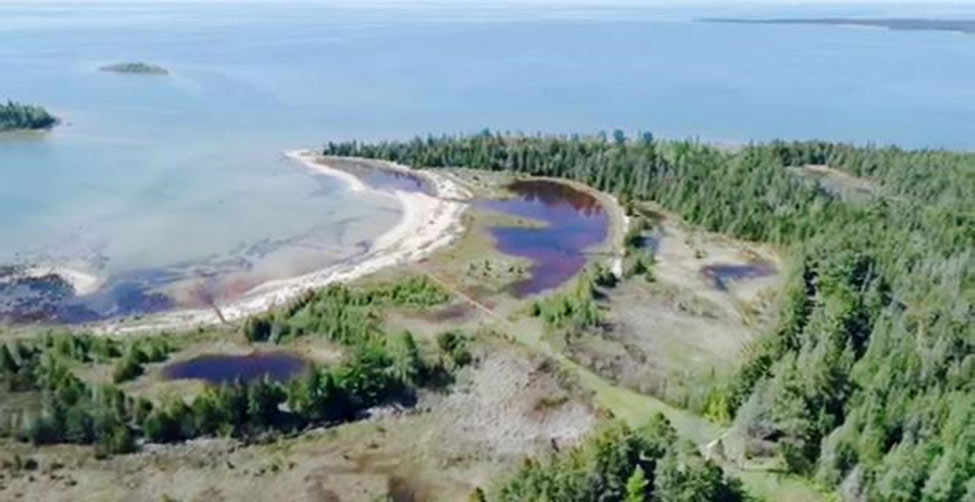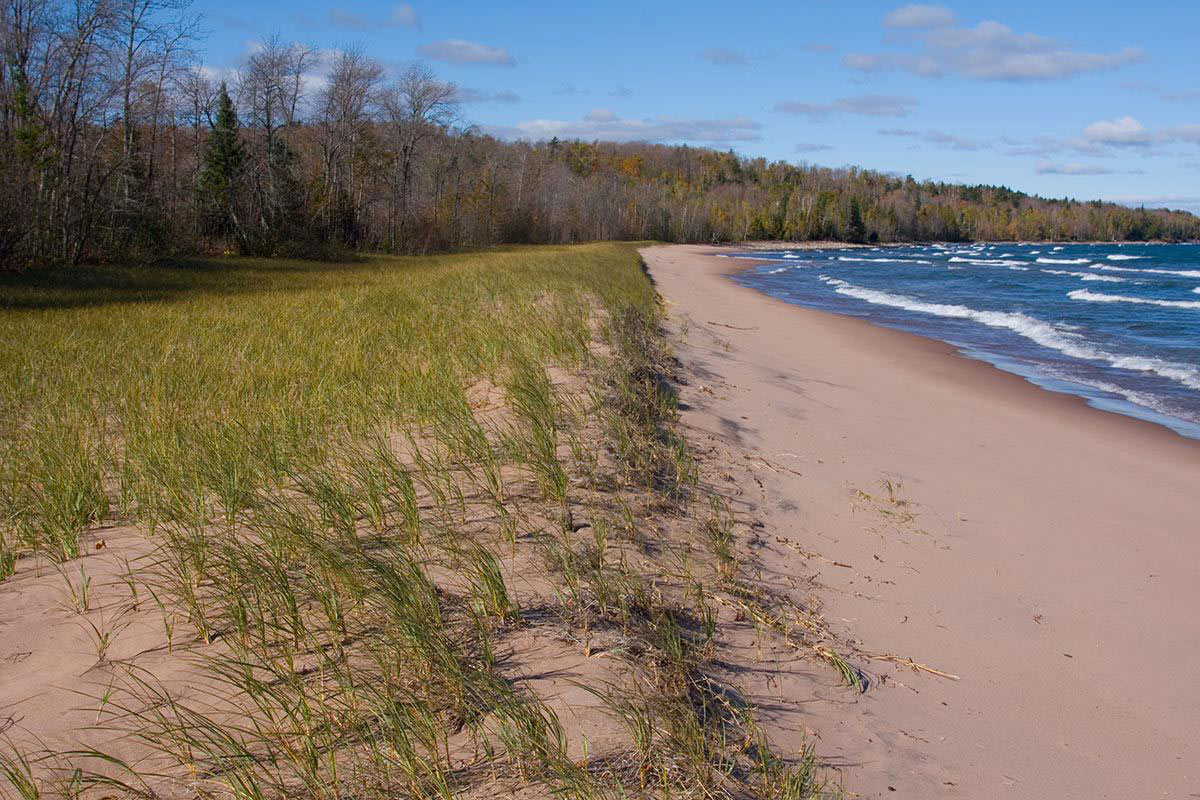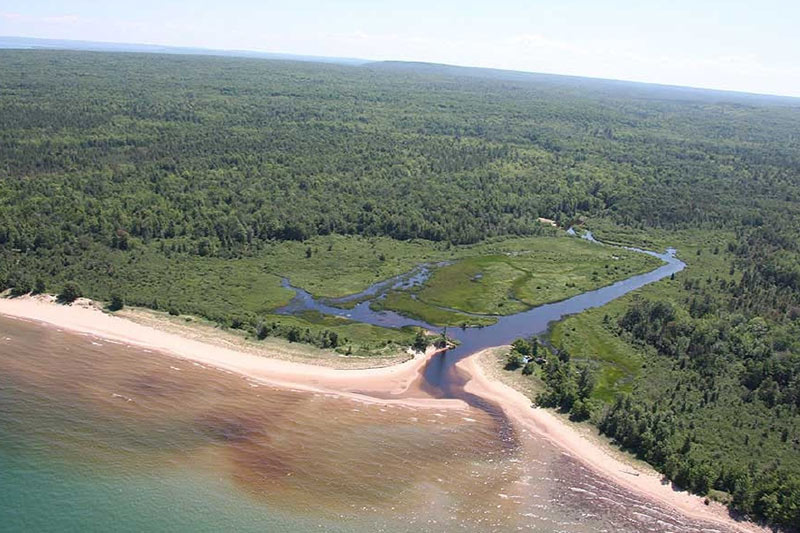Land Conservancy
If you or someone you know has land they want to see forever protected, please contact our office and a Land Protection Specialist can help you.
Here are a few Great Lakes coastal properties owned by the SWP Land Conservancy.
All are open to the public. For more information please contact the SWP!
Lake Huron Community Forest
The Lake Huron Community Forest is located on the shores of Lake Huron near De Tour Village in Chippewa County, Michigan. The parcel is located in the St. Marys Watershed (USGS Hydrologic Unit Code: 04070001) and includes 17 acres of freshwater forested/shrub wetland and old growth northern forest bordered by 1,687 feet of Lake Huron shoreline. Land use/cover types include forested uplands (including old growth white pine); forested, emergent, and rare fen wetlands; and Lake Huron sand beach. Located in an area where costal development pressures are at an all-time high, the parcel will serve to preserve important coastal ecosystems and to provide educational and recreational opportunities for area residents and tourists. The SWP acquired the $777,000 parcel using $400,000 in Community Forest Program funds.
Eagle’s Nest Community Forest
Located just north of the City of Marquette in the Upper Peninsula of Michigan, the Eagle’s Nest Community Forest includes 17.83 acres of old growth northern forest and coastal wetlands bordered by 1,130 feet of Lake Superior shoreline. Previously owned by the same family since 1870, the Superior Watershed Partnership (SWP) acquired the property through the Community Forest Program (CFP) to protect it from future development and preserve it in order to provide numerous community benefits in perpetuity. The community forest will provide multiple educational and recreational opportunities for area residents and visitors year-round including hiking and cross country ski trails, nature watching opportunities, and public access to unique and varied coastal ecosystems. The SWP acquired the $800,000 parcel using $400,000 in funds provided by the CFP.
Laughing Whitefish Community Forest
The 82 acre Laughing Whitefish Community Forest is located adjacent to Lake Superior in Alger County, Michigan. The Community Forest is dominated by forested uplands (including old growth white pine), forested and emergent coastal wetlands, the mouth/estuary of the Laughing Whitefish River, and Lake Superior sand beach (2,000 linear feet). Located in an area where costal development pressures are at an all-time high, the parcel will serve to preserve important coastal ecosystems and to provide educational and recreational opportunities for area residents and tourists. The Superior Watershed Partnership acquired the $1,000,000 parcel using $400,000 in funds provided by the Community Forest Program.
What is a Conservation Easement?
A conservation easement (sometimes also referred to as a conservation restriction) is a voluntary, legal agreement between a landowner and a land trust, such as the Superior Watershed Partnership, or government agency that permanently limits uses of the land in order to protect its conservation values. It allows you to continue to own and use your land and to sell it or pass it on to heirs.
When you donate a conservation easement to a land trust, you give up some of the rights associated with the land. For example, you might give up the right to build additional structures, while retaining the right to practice sustainable forestry or grow crops. Future owners also will be bound by the easement's terms. The land trust is responsible for making sure the easement's terms are followed on a long-term basis.
Conservation easements offer great flexibility. An easement on property containing rare wildlife habitat might prohibit any development, for example, while one on a farm might allow continued farming and the building of additional agricultural structures. An easement may apply to just a portion of the property, and need not require public access.
A landowner sometimes sells a conservation easement, but usually easements are donated. If the donation benefits the public by permanently protecting important conservation resources and meets other federal tax code requirements it can qualify as a tax-deductible charitable donation. The amount of the donation is the difference between the land's value with the easement and its value without the easement. Placing an easement on your property may or may not result in property tax savings.
Perhaps most important, a conservation easement can be essential for passing land on to the next generation. By removing the land's development potential, the easement lowers its market value, which in turn lowers estate tax. Whether the easement is donated during life or by will, it can make a critical difference in the heirs' ability to keep the land intact. If you would like to learn more about conservation easements please contact the Superior Watershed Partnership.



